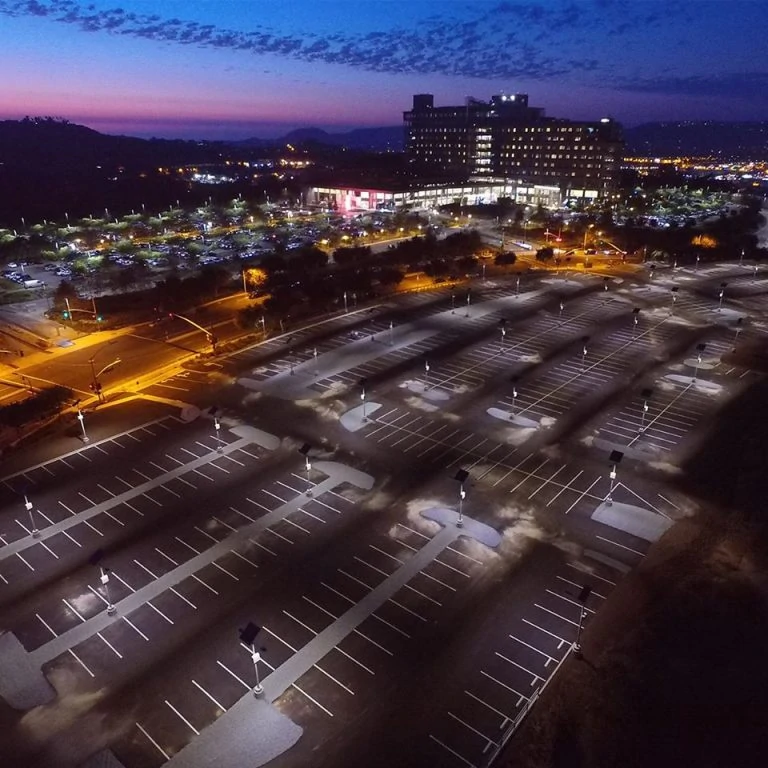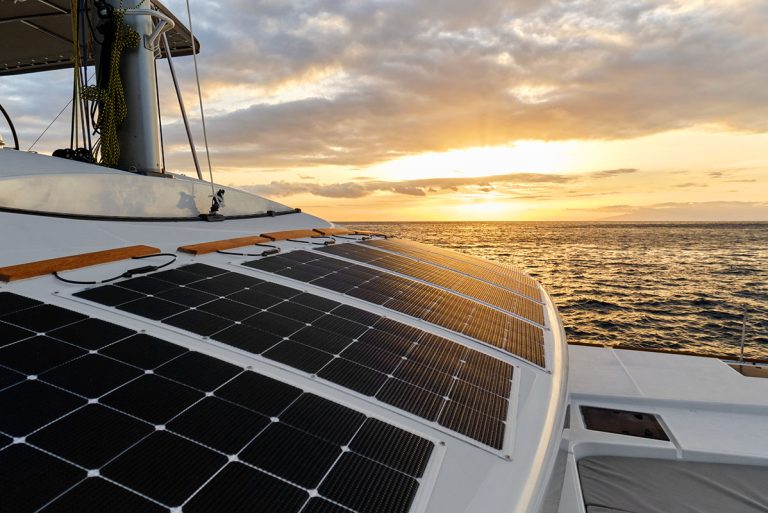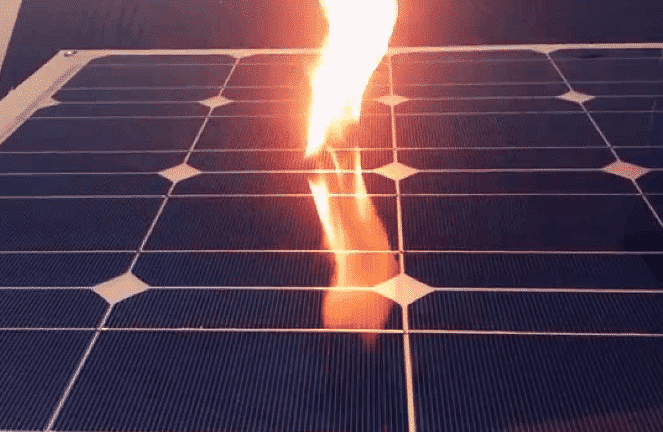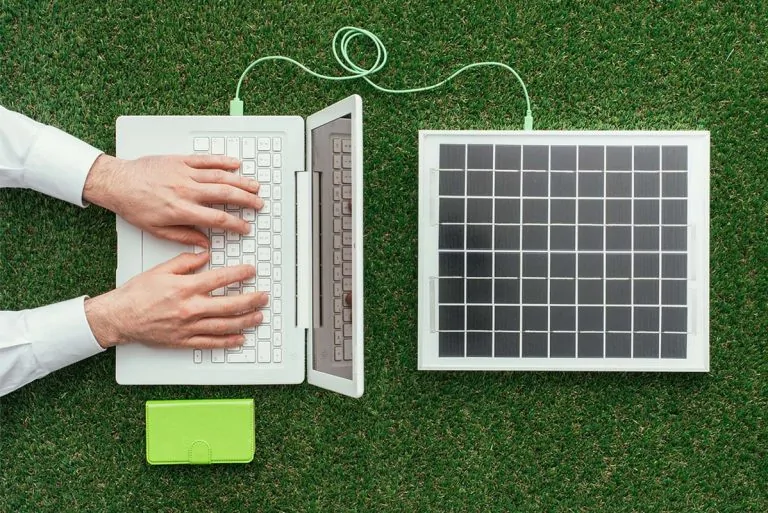Are you a suburban or rural homeowner in search of a renewable energy system, but rooftop solar just isn’t right for you? Then consider the many advantages of ground mount solar systems compared to their disadvantages. Four times as many pros as cons — at least!
In this article, you’ll find out why a backyard photovoltaic (PV) system deserves a serious look to meet all your home energy needs both now and in the future.
What is a ground mounted solar system?
A ground mounted solar system, like rooftop solar panels, is a set of photovoltaic cells that produces direct current (DC) electricity from the sun. Instead of being placed on the roof, the ground mount array is situated somewhere on your property, usually the backyard.
There are a number of ways to arrange a ground mount system. The two most common are the standard (fixed) type or the pole-elevated variety.
Standard (fixed) ground mount solar system
You’ve probably seen a rooftop PV array.
Now imagine transferring that setup — racking and all componentry and wiring — on to a fixed metal scaffolding that is usually cemented into place. The arrangement is most often placed in a backyard location where there is suitable soil for secure construction and plenty of sunshine. It may be several inches or many feet off the ground, precisely angled and oriented for maximum sun exposure.

The result is called a fixed ground mount solar system. It is the most common type of ground mount system you’ll see today.
Pole mount solar system
As the name states, a complete PV array situated on a single, tall pole is known as a pole mount solar system. Not as common at private residences as standard ground mount systems, you may spot them on roadsides, powering electronic traffic signs.
One of the major advantages of pole mount solar systems over fixed versions is that there is plenty of space underneath where animals may seek shade or shelter.

So, if you have a few acres or more, a pole mount solar system (or several) dotting the landscape is compatible with grazing animals at the same time that you’re capturing the sun’s renewable energy. It falls on your land to power your home and other buildings scattered over your property. You could even grow food in some places around them.
Another important consideration with pole mount solar arrays is that they are perfectly suited to be integrated with sun-tracking systems. The panels move as the sun traverses the sky, either daily and/or annually. Their sole objective is to allow your PV modules to seize as much radiant energy as possible all the time (not just for the 4-5 hours/day of peak sunlight).
Solar tracking systems for free-standing solar arrays
There are several different types of solar tracking systems. Most of them are either single-axis or dual-axis.
In general, single-axis systems move along just one axis (typically vertical). Dual-axis trackers move horizontally as well as up and down.
- Single-axis tracking systems permit PV cells to be 33% efficient compared to fixed ground mount panels (at most 23% efficient). This equates to a 15% energy production gain compared to what a same-capacity fixed mount system does.
- Dual-axis trackers perform even better: 45-50% more energy output. The initial price tag could go as high as $3,500-$6,500. But you will see higher savings in energy costs over time as long as the system is well-maintained and the sun keeps shining.
What are the pros of ground mounted solar panels?
There are so many advantages of a ground mounted solar system that it’s difficult to know where to begin. Here are 13 pros, in no particular order.
1. Ideal in suburban or rural settings
If you have a small yard with at least some of it completely free of all obstruction, you may be a good candidate for a ground mounted solar system. But everything depends on how much electricity you wish to generate on a daily basis.
More specifically, for a 10 kW size array — plenty for an average American household — you need approximately 1,000 sq. ft.

The land should be wide open without anything that could cause shading issues, including trees, fences, or buildings. It’s a good idea to stay away from property lines to avoid potential problems in the future if your neighbors build or plant trees.
2. Greater flexibility with angle, orientation
Unlike rooftop solar where the pitch of your roof limits you, you have no such restriction with a ground mount system.
You can orient your backyard solar setup to optimize the capture of the sun’s energy by your PV cells. South- or west-facing roofs are ideal. The best angle will vary from region to region and change during the day and over the course of a year.
If you capitalize on superior angle placement even more with a tracking system, which pole mounted solar systems make easy, you will be able to maximize your panels’ capacity to create electricity for your home needs all the time, all year long.
3. Greater energy productivity per panel
The highest quality PV panels have an efficiency up to 22-23%. Lower priced modules may achieve only 15-18% efficiency. When they are fixed to a roof with a sub-optimal angle and orientation that is not conducive to maximal solar energy production, the efficiency will drop even more. This means there will be less electrical energy production to power your home.
By contrast, your solar installer — or you, if you DIY your own solar system — will orient and angle the photovoltaic modules such that they are as efficient as possible even given their fixed position.
Free software called the System Advisory Model (SAM), provided by the National Renewable Energy Laboratory (NREL), will enable you to calculate the energy production of your solar system based on your location and tilt angle of your modules. This determination is essential when designing your home solar array.
Consequently, you’ll enjoy greater energy production and more energy savings.
With tracking systems, efficiency and productivity will increase even more. Normally a 15-30% rise in energy production (compared to a fixed system of the same capacity) will result.
4. Eliminates rooftop restrictions
Do you have a roof in need of replacing? Possibly one too small to meet your energy needs? Or maybe it’s heavily shaded by trees or chimneys. Worst case is that it’s facing north.
All of these and similar reasons may reduce the feasibility of a rooftop solar project for you. But they don’t have to prevent you from exploring free-standing solar systems. As long as you have a sunny, open area of the required dimensions, ground mount solar could be just your ticket to carbon-free energy freedom.
5. Requires no roof drilling
Unfortunately, PV modules can’t simply be placed on top of your roof without fasteners. This is so because it’s essential to maintain a few inches (at least) of space under them for air flow. The cooling effect of air currents is needed around PV modules since their efficiency, and, likewise, their total energy output, drops when the temperature rises in warm weather.
So, the panels need to be placed on brackets and bolted into place.

On your asphalt roof. (To be fair, some metal roofs don’t require bolts for the mounting brackets but possibly will for the wiring.)
If you have a good solar installer, or you’ve taken the time to learn how to do it right, sealing the holes to prevent water leakage should be easy and foolproof. If not, you’ll have a costly mess on your hands especially in areas experiencing climate crisis-intensified heavy downpours.
Backyard solar — by definition — will never damage your home’s roof.
6. Fewer electrical hazards, safer grounding
Another potential issue with rooftop solar is the risk of lightning causing an electrical fire due to the high voltage on your roof in some arrays or to surges during storms. Also, a faulty grounding could result in a fire or damage to your solar system.
A ground mount system circumvents these problems somewhat since it is lower to the ground to begin with, thus making grounding simple and lightning strikes less likely. This doesn’t mean grounding problems won’t occur with the age of your system, as is known to occur. But that’s why regular system checks by a qualified solar professional are a good idea.
7. More efficient cooling
Contrary to popular belief, solar panels are more efficient at converting the sun’s rays to electricity when it’s cold outside. The electronics function much more smoothly.
During warmer months, high temperatures contribute greater resistance to the passage of electrical current. Panel efficiency proportionately drops. Cooling the panels is necessary to maximize efficiency as much as possible.
A free-standing system allows plenty of airflow under and around the modules. Heat buildup more easily dissipates compared to a rooftop system.

A backyard system also allows you to install bifacial solar panels to intercept the sunlight reflected back off the ground under your PV modules.
8. Can more closely match your home’s energy needs
When designing any photovoltaic system, the first step is calculating your home’s energy usage. Then figure out the percentage of that value you’d like to be met from the sun.
With a ground mount solar system, you have lots of leeway to build up a system exactly to your specifications. And enough space to fit it in.
By contrast, a roof of fixed dimensions limits the size — and, so, the energy capacity — of your solar array.
9. Can be moved if needed
You may not be able to move the entire concrete platform or the ballast that is anchoring your backyard system in place. But you can certainly relocate the PV array and re-stabilize it in a more optimal place if the situation warrants it. All without drilling any holes in your roof.
By comparison, your roof isn’t as versatile. Where the panels were first positioned is their forever home.
10. Over the long-term, ground mount will more than pay for itself
Most Web sources will tell you that ground mount solar systems are — by far — more expensive than similar-capacity rooftop solar arrays.
Fortunately, this is not always true.
Granted, there will be higher upfront costs, especially for laying the concrete foundation of some type (if you go that route) and installing the scaffolding or pole, compared to a rooftop system. But possibly you will do these parts yourself and save money.
But if you take into consideration the fact that solar adds an average of $15,000 to the value of your home, it is very possible that your ground mount solar system will pay for itself in a decade or less.
You can accelerate the high return on investment (ROI) with government tax incentives or vendor rebates. Tracking systems will boost productivity, thus lowering your energy costs and raising your monthly solar renewable energy certificates (SRECs) even more.
In other words, backyard solar may just be more affordable than you realize — or possibly less expensive compared to a similar capacity roof system.
11. Solar tracker options
Tracker systems are made to work on ground mount solar systems where there’s ample space to raise, lower, or move the panels side by side.
No such possibility exists with rooftop solar — at least to the same degree.
Although it is true that enlarging the array on a roof (assuming there’s space) or in a backyard system may result in comparably increased energy productivity, enhancing the initial array with a tracking system will accomplish the same goal.
The advantage with the sun-tracking versus adding more panels is you’re not purchasing additional PC modules, thereby contributing to a heightened demand to manufacture more panels. Making panels demands fossil fuel-intensive mineral extraction involving environmental degradation but there is mounting pressure to improve production methods.
So tread more lightly on the earth with a solar tracking system for your ground mount solar system.
12. Easy future expansion
If you decide later to build a greenhouse, shed, or barn on your property, the versatility of a ground mount solar system will enable you to power it simply by adding a greater number of compatible panels to your existing PV array.
Likewise, if you decide to build an addition to your main residence and wish to have your ground mount system carry the energy load of it, expanding your current solar system will make it happen.
Incidentally, none of this expansion would be possible within the rigid constraints of a fixed rooftop solar setup (unless you swapped out panels to high wattage and/or more efficient versions but even these measures may not be enough to supply all your energy needs).
13. Accessible maintenance
Since the free-standing solar arrangement on your property is usually close to or below the height of adults, sweeping off snow or removing dust is very manageable. Both snow and dust impede the energy production of photovoltaics.
If there’s a mechanical failure, a technician will have easy access, too. No climbing on roofs with high-voltage around.
What are the cons of ground mounted solar panels?
It takes some thought to come up with disadvantages of ground mount solar systems because there are so few.
But then again, one or more could be a deal breaker for you. Each person’s case is different so there are no hard and fast rules when it comes to figuring out the best home solar system for you.
Here are three cons to ground mounted solar systems:
1. Usually higher initial costs
The labor to prepare the terrain and install some sort of anchoring system for the poles and/or metal scaffold may raise your final cost by $5,000 or more.
Doing it yourself will save you the labor costs.
Of course, a solar tracking system will up that total even more – possibly by another $3,000 – $5,000 on average.
However, when energy savings over time coupled with government tax breaks, company rebates, solar renewable energy certificates (SRECs), and increased home value are taken into consideration, your backyard solar system will soon pay for itself.
And it will reduce your personal carbon footprint, too.
2. Unobstructed land required
For folks living on a small (less than 0.2 acres) plot of land, you don’t have much room to work with. You definitely need an area that’s wide open to the sun’s rays.
It helps if your neighbors won’t build or plant trees close by either. (A long-term “if” since your array will last for 25-30 years.)

Then again, if you have a half acre or more of land, it’s possible to transplant the system elsewhere if obstructions come into play, even though it’s a pain and costs money.
3. Safety concerns (kids, pets, farm animals)
Children and animals love to move, including, in most cases, jumping.
Just not on solar panels in the backyard!
An enclosure around your backyard PV array could prevent accidents from contacting high voltage wires or damage to the glass panels caused by rambunctious kids or animals.
Lastly, if your ground mount system is on a lawn, watch out when mowing. A flying rock or branch could damage a low-lying PV panel.
Summary table of pros and cons of ground mounted solar systems
Here’s a quick snapshot of the main advantages and disadvantages of backyard solar systems.
| Pros | Cons |
|---|---|
| Ideal in suburban or rural settings | Usually initial costs are higher |
| Greater flexibility with angle, orientation | Unobstructed land required |
| Greater productivity per panel | Safety concerns (kids, animals) |
| Eliminates rooftop restrictions | |
| Rooftop drilling not required | |
| Fewer electrical hazards, safer grounding | |
| More efficient cooling | |
| Can more closely match your home energy needs | |
| Can be moved if needed | |
| Will pay for itself over time | |
| Solar tracker options | |
| Easy future expansion | |
| Accessible maintenance |
FAQs about ground mount solar systems
During your research into free-standing PV arrays for your home, you’ll likely have many questions to consider. Here are some questions you may wish to think about. Confirm your research findings by consulting with certified solar professionals.
Q: Are ground mounted solar panels better than rooftop solar panels?
A: There is no right answer to this question. Since everyone’s case is different, you must consider all pros and cons.
In general, ground mount systems with solar tracking provide the highest level of energy production per panel compared with similar capacity rooftop panels of fixed orientation and angle.
Urban dwellers may not have an option due to lack of roof space or risk of theft if the array is on street level in which cases only rooftop solar is possible.
Q: How far from a house can ground mounted solar panels work?
A: It is possible to install your free-standing solar system several hundred feet from your home but you’ll probably encounter a voltage drop over that long of a distance. It will also involve lots of wiring and trenching to bury it.
Too far away means your energy production will be reduced.
It’s best to keep it as close (10-20 ft.) as possible to your home. However, make sure your home’s shadow doesn’t fall across the panels by scoping out the location before installation and observing the sun’s trajectory over it throughout an entire day.
Q: How much land do I need for ground mounted solar panels?
A: As a general rule of thumb, figure that PV panels capable of producing 1 kW of power per day need 100 sq. ft.
So if your ground mount solar array produces 10 kW/day on average (more than enough for an average American home), you should plan on 1,000 sq. ft. of unobstructed land for all of the panels in the array.
Q: What are tilt and azimuth angles? Do I have to be concerned about them for a home solar system?
A: To optimize the energy output of your home solar array, both rooftop and ground mount, it’s important to consider the position of the photovoltaic modules. Their position includes:
- Their direction in relation to the sun (south-facing toward the equator is best, north-facing is worst)
- Your latitude (the angle above or below the equator)
- Their angle in relation to a horizontal plane (tilt angle)
- Their placement in relation to the north on a compass (azimuth angle)
- The orientation of the modules (either portrait or landscape)
PV panels that are directly below the sun capture the maximum amount of solar radiation. This is when they are perfectly perpendicular to the incoming solar rays.
Yet, the sun moves in the sky during the day in a horizontal manner. It’s higher in the sky during the summer and lower in the winter. This means your solar panels are not exposed to the sun’s radiation equally at all times in the year or even in a single day.
Experts estimate that the optimal tilt angle for PV cells, taking all the sun’s movements into account, is approximately the same as your latitude. In the USA, for example, Phoenix, AZ is at 33 degrees north and Portland, OR is at 45 degrees north latitude.
You can easily determine your latitude from a map or by using an online tool.
At the tilt angle, the incoming solar radiation lands perpendicularly to the photovoltaic cells, and maximum solar absorption results.
By contrast, the azimuth angle reflects how much the panels diverge from true south (considered zero degrees) where they’d receive maximum sun.
If your home’s rooftop solar is not directly situated southward, the azimuth angle will have a non-zero value. The array in this case may be oriented in a southeasterly or southwestly direction. Basically, the azimuth angle is a way to quantify the east-west orientation of your array.
An added complication when figuring out your array’s azimuth angle is caused by a phenomenon called magnetic declination created by the earth’s magnetic field. This is why a compass does not point to the true north.
To determine the magnetic declination in your area, you can use this online tool. When determining your exact azimuth angle, you add or subtract the magnetic declination to the standard azimuth angle (zero degrees = facing true south) depending on where you live.
Using tilt and azimuth angles for ground mounted solar system design
In ground mounted solar systems without a sun tracker system, use your latitude for the tilt angle. If you can, during the winter, move them 15 degrees above your latitude to maximize energy capture. Likewise in the summer, move them 15 degrees below your latitude to collect more solar radiation.
Furthermore, aim for placement of the scaffold or pole of your backyard PV array toward the true south.
Using tilt and azimuth angles in rooftop solar system design
Installers of rooftop solar arrays typically use the roof’s pitch as the tilt, no matter how different it is from the ideal angle at your latitude to achieve perpendicular solar rays resulting in maximum solar absorption. If you’re a DIYer, you can construct a mounting bracket system at a specific tilt taking the roof’s pitch into account, too.
If so, aesthetic concerns come into play as well as hazards from wind storms when the array is significantly raised from the roof on one end. The entire system could blow off.
With rooftop solar, it is easier to take the azimuth angle into account compared to the tilt angle. Direct the PV modules true south even if your home veers off of that line even by a few degrees. This may require different heights of mounting hardware on one end of your array versus the other. You could also run into problems with high winds.
Key takeaways on the advantages and disadvantages of ground mount solar systems
When you’re a homeowner in search of energy independence, there are many pressing questions to consider. At the top of the list is whether rooftop or backyard solar is better for you.
Unless you’re a city dweller with limited space, people living in the suburbs or the country could benefit greatly on a long-term basis with a free-standing PV array on your property.
In all cases, it’s wise to consult with certified solar installers before purchasing. That way, you’ll be optimally placed to enjoy energy cost savings, and, if you so choose, expand them in several different ways outlined here during the 25-30 years of your ground mount solar system.






![Eco-Worthy Solar Panel Review 2024 [Includes Buyer’s Guide]](https://greencoast.org/wp-content/uploads/2019/02/Eco-Worthy-Review-and-Buying-Guide-e1574180788859.jpg)




